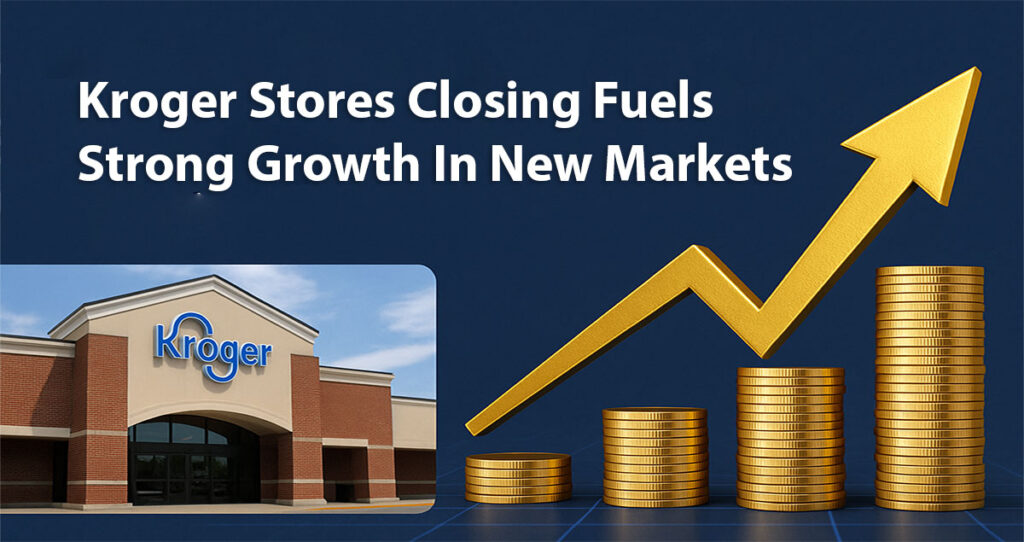After Kroger announced that it would close 60 stores within 18 months, this move was initially viewed by most people as an act of desperation. Nevertheless, these shutdowns are tactical corporate plans that can allow the firm to operate in high-growth markets. This grocery chain is closing about 5 percent of its 1,239 stores to reinvest in online innovation, operating efficiency, as well as growth in profitable markets.
Understanding the Strategy Behind Kroger Store Closures
Kroger’s closing of the struggling stores is part of the wider trend that is taking place in the grocery industry. The consumer shopping trend has changed radically as consumers increasingly have been adopting online ordering, curbside pick up and home delivery services. Such changes have rendered some of the traditional store forms less viable and opened the potential for elevated digital services.

The closures were not done randomly but following careful analysis of the performance of each location. Such decisions to close stores are made by Kroger by considering the volume of their sales, the number of people passing, the cost of running the store, and competition in that area. Those stores that systematically underperformed or those in the oversaturated markets are highlighted to close down and release capital to invest in better-promising ventures.
This will run contrary to the traditional retail way of thinking that success was synonymous with the quantity of locations. One would think that the current grocery environment is more rewarding to efficiency, customer satisfaction, and versatility rather than just the number of stores. Kroger is aware of the fact that sustaining unprofitable sites is a waste of resources that could produce a higher margin in another place.
How Store Closures Support Digital Growth
The savings on the cost of shutting the underperforming stores do not dry up, as it is invested in the digital infrastructure of Kroger. It has been capturing more e-commerce, enhancing its mobile app, and creating new delivery services within the company. These investments require significant capital that becomes available when unprofitable locations are eliminated.
Kroger’s digital transformation includes several key areas:
- Enhanced Mobile Shopping: The company is still refining its mobile app to enhance an easier and personal experience in online grocery shopping. The use of such features as digital coupons, shopping lists, and product recommendations also saves time and money for the customers.
- Delivery Expansion: Kroger has been expanding the scope of its delivery to a broader range of customers, even to same-day delivery in most markets. The company works closely with third-party services and has its delivery its delivery network, which is flexible.
- Automated Fulfillment: The capital can be used to open automated fulfillment centers where they can handle online orders faster than stores, in some cases, which is invested in store closures. These warehouses use robots and the concept of artificial intelligence to pack and sort orders very quickly and accurately.
- Customer Personalization: This is done because their data analytics is very sophisticated, and therefore Kroger can understand the personal preferences of each shopper and give them recommendations. This customized treatment helps in increasing customer satisfaction and makes them repeat business.
Targeting High-Growth Markets and Demographics
Instead of just reducing the costs, Kroger saves the money and ventures into new markets that will enjoy immense growth. The company targets the regions that have positive demographics, such as a growing population, increased household income, and fewer competitors among large grocery chains.
Kroger’s expansion strategy prioritizes several types of markets:
- Suburban Growth Areas: There is a lack of adequate grocery stores in the fast-growing suburban communities, and therefore, Kroger has the potential to entrench itself before its competitor can enter the market.
- Urban Centers: There are still some undervalued markets in the city, with the existing groceries, especially those with quality products and low prices, like what Kroger has to offer.
- Demographic Sweet Spots: Regions having a large number of young families and professional audiences tend to record high interests in convenient grocery delivery, both in pickup and delivery services.
To get into a new market, the company will also take into account the preferences and needs of the locals. This may take the form of collaborating with local vendors, making product assortments more to the needs of the surrounding area, or store formations.
Financial Benefits of Strategic Closures
Financially, the closure of underperforming stores will give cost savings in the short term as well as create chances to reallocate resources. The company cuts down on the cost of rent, power, employees, and stock in places that were not turning enough profits.

These savings contribute to improved profitability in several ways:
- Reduced Operating Costs: Cutting off the unprofitable locations directly increases the bottom line of the company because it reduces recurring expenditures.
- Better Resource Allocation: The money that was being wasted on stores that were not performing adequately can now be channeled into an investment that has high potential, such as upgrading technology or even coming up with a new store.
- Improved Efficiency: The customer traffic at the remaining stores tends to increase as it is possible to understand that shoppers of the dead stores turned to the closer Kroger store, positively affecting sales density.
- Enhanced Focus: Fewer places will allow Kroger to maintain the remaining stores and provide the resources to facilitate their existence, to work mainly as far as the increase of their efficiency is concerned.
Competitive Positioning in the Grocery Industry
The Kroger strategic model assists the firm to compete better in the market compared to its competitors, such as Walmart, Amazon, among other local grocery stores. With the possibility to invest the resources in the places where it can earn more and in areas where it can expand, it will be possible for Kroger to provide lower prices, improved services, and experience to their clients.
The company’s competitive advantages include:
- Scale Benefits: Being one of the biggest grocery retailers, Kroger can barter lower prices to suppliers as well as distribute the costs of operations among the large number of customers.
- Technology Investment: The freed resources due to the closures of stores can be used towards further investment in digital capabilities, which smaller market rivals cannot afford to a great extent.
- Brand Recognition: Customer and brand loyalty Kroger has is a source of leverage in the harvesting period it decides to launch itself in another market or even when it will have to engage another chain in the market.
- Operational Expertise: Kroger has tens of years of experience in retailing groceries and which helps to optimize the work in its stores, supply chain, as well as customer relations.
Improving Customer Experience Through Strategic Focus
The closing of the stores enables Kroger to focus on offering optimal service in those that are not shut down. This improved quality rather than quantity gains the customers with better store conditions, selection of products, and various kinds of good services.

Customer experience improvements include:
- Store Upgrades: The proceeds of closure can be put into renovation and other improvements to the current stores, making them more appealing to shoppers.
- Better Staffing: Better customer care occurs with consolidated operations as there can be better training of the staff, as well as possibly an increase in their wages.
- Enhanced Services: Additional investment and attention can be devoted to the popular services such as pharmacy, deli, and bakery departments.
- Technology Integration: The inconvenience of shopping is reduced by the level of technology in the stores, self-checkout machines, etc., and also the ability to make the payment with the help of a mobile phone.
Building Sustainable Growth Models
The store closure strategy embraced by Kroger is geared towards long-term sustenance because it makes the store efficient and able to adjust to the dynamic operations in the market. The plan assists the firm to ride the economic storms and be ready to take advantage once the situation improves again.
Key elements of sustainable growth include:
- Operational Flexibility: Retaining the flexibility of manipulating store structures to meet conditions in the market and the demands of the customers.
- Technology Adaptation: Ongoing investment in relevant digital capabilities that continue to change customer expectations.
- Market Responsiveness: The Capability to able to enter new possibly potentially profitable markets and exit from less profitable markets within short turnaround times.
- Financial Discipline: Evidence-based judgments on the need to utilize resources in such a way that the risks could be minimized as as possible, with the mitigation of risks.
Impact on Local Communities and Employees
Although the closure of stores is a challenge to the affected communities and their employees, Kroger has been putting in effort they reduce adverse effects through various measures of support. The firm also frequently gives its workers the chance of a job transfer, and continues with services in the affected regions with nearby stores or road delivery.
Community impact considerations include:
- Employee Support: When the company closes down a store, it, in most cases, transfers the employees to other branches and offers support during the transition period.
- Continued Service: Customers of closed stores may usually get the services of Kroger via local stores, internet delivery, or internet purchase.
- Economic Effects: Although the closure of stores can decrease the number of jobs available locally, it can make other stores increase their performance and competitiveness.
- Future Opportunities: Strategic shutdowns can even open up opportunities to move into the same markets in the future when things have changed.
Looking Ahead: Future Growth Opportunities
The strategic nature of Kroger in shutting down stores is an advantage in enabling the company to grow better in the future, as the grocery business evolves. The capital generated by shutting down the underperforming distribution gets flexibility to open up to the new prospects and makes adjustments to new market dynamics.
Future growth areas may include:
- Continued Digital Expansion: More investments in e-commerce technology, the delivery channel, and technology served to customers.
- New Market Entry: Entry into the markets that have good demographics and less competition.
- Format Innovation: Formation of new store types that may be segmented according to customer need or market situations.
- Strategic Partnerships: Partnership with other firms in order to upgrade services or contact new customer groups.
Conclusion: Strategic Transformation in Retail
In this age and era of retailing, strategic thinking is at an advanced level when Kroger closed weak businesses as it invested in prospects of expansion. Instead of considering closures as losses, the company perceives them as a necessary measure in the creation of a more efficient and profitable entity.
It is also consistent with the wider forces in the retail business where the tailoring of the organisation to the needs of its customers, flexibility, and intelligent use of resources are becoming more important determinants of success than the mere ability to remain in as many locations as possible. Businesses that can trace the weak-performing pools and move finances to the high-potential businesses would be in a better position to succeed in the long run.
To Kroger, store closures are not the end, but rather a transformation where they will not just think in terms of how many stores are open, but rather in terms of quality and efficiency of the stores over expansion to address simple growth issues. The strategy gives a chance of sustained growth in a modern society that is facing enormous competition and a fast-moving grocery business.
Digitalization skills, commitment to growth, and cost effectiveness mark the Ideal combination to make the company a favorite customer-serving force and a revenue creator to the shareholders. As the grocery market keeps changing, the strategic solutions to having the right number of stores that Kroger has applied are an example of how traditional retailing companies can thrive in the new demands of the market environment.






